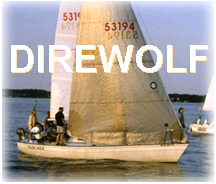

BULKHEAD REPLACEMENT PROJECT
I had a sneaking suspicion that the bulkheads on "Dire Wolf" were pretty much shot, but when I went down to the boat to start the 2004 Spring Refit and poked around the chainplates with a knife blade, I was surprised we hadn't had a catastrophic failure last year.
So, we put the wheels in motion to get the old ones out and new ones installed. A bunch of credit should go to Dan Witucki's write-up on the WestSystem website. His instructions made the whole process a lot easier.
Dan recommended using G-10 as the material to replace the old plywood, but when I went on the Sailing Anarchy forum to ask where I might get a deal on this stuff (it ain't cheap), a bunch of people said G-10 was overkill and really heavy, to boot. A really helpful guy who works at Oceana Limited in Annapolis suggested I come down and look at a material they stock called Coosacomposite. I decided to go with their .75 inch material and the price was competitive with high grade marine plywood. Much thanks to the great folks at Oceana Limited.
First thing to do, without doubt, is to take measures to control dust and ventilate the boat. Anyone who's ever sheet-rocked a house knows what a pain in the ass the dust situation can be. Consider this job to be equally as dusty if not worse. Here's a diagram showing how we dealt with the situation and even this was barely adequate. Given more time, I'd have taken more care to button up everything below.
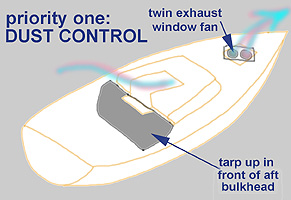
Basically, we just used a Sawzall to cut out the old bulkheads and did a pretty rough job of it. We just tried to retain some semblance of the shape of the original bulkhead, but didn't sweat it in terms of making it pretty. We left a lot of tabbing and cracked plywood still attached to the inside of the hull, but it all got ground out anyway with a 4.5 inch angle grinder and a 36 grit wheel. This is where things get really dusty. Make sure to wear a decent half-face dual cartridge respirator. Long pants, socks, long sleeves and a hat and gloves are also advisable. A Tyvek suit is even better.
From what was left of the old bulkheads, we made templates. We went to an intermediary form that was made from pink insulation panels. This was easy stuff to take below and "fine tune" the shapes that would conform to the inside of the hull.
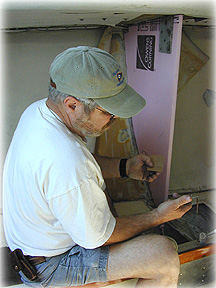
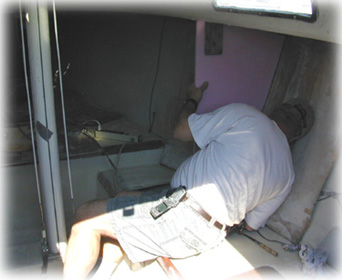 "The
First" makes final trims on the intermediary templates...they fit like
a glove after some easy trimming.
"The
First" makes final trims on the intermediary templates...they fit like
a glove after some easy trimming.
"First" (G.F. Cerrone) is an independent marine contractor and his business,"Chasse Mare'e Boatworks" is reachable at mspgfc@toad.net. He can fix anything and does excellent work.
From the pink insulation templates, the Coosacomposite material was cut on a band-saw (equipped with a vacuum system); this stuff is itchy as heck! wear gloves just carrying it.
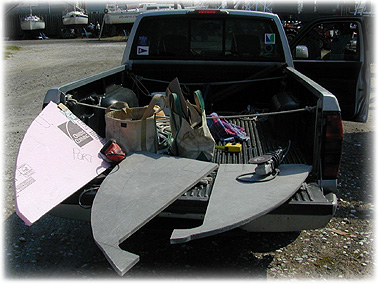
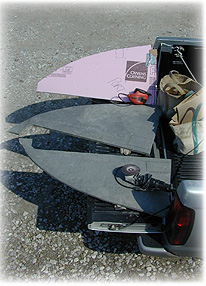 Angle
grinder was used to take off any remaining high spots (frankly, the grinder
was overkill...coosa composite works as easily as pine or any soft wood)
Angle
grinder was used to take off any remaining high spots (frankly, the grinder
was overkill...coosa composite works as easily as pine or any soft wood)
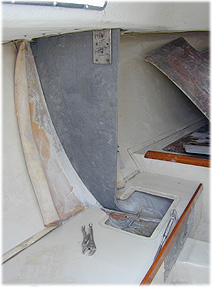 Final
fit, prior to glassing in the new bulkhead...
Final
fit, prior to glassing in the new bulkhead...
Prior to glassing in the new material, I took it home and put a layer of cloth on both sides of the two new forms. I cut the cloth to leave an inch or two of uncovered coosa composite at all locations that were to be tabbed in against the hull and coach roof (see diagram below)
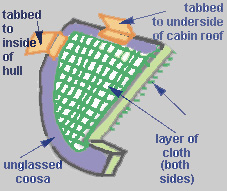
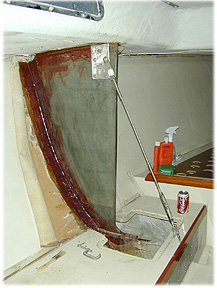
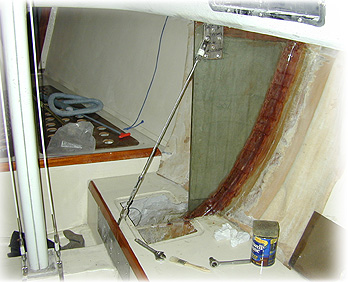 We
tabbed the new material in pretty much as described in Dan Witucki's description...mixed
up some WestSystem epoxy and went at it. Filletted the peanut butter-like stuff
in and then tabbed with 4-6 inch lengths of 4 inch wide cloth tape. Two applications
of epoxy on top to smooth and finish off the surfaces..
We
tabbed the new material in pretty much as described in Dan Witucki's description...mixed
up some WestSystem epoxy and went at it. Filletted the peanut butter-like stuff
in and then tabbed with 4-6 inch lengths of 4 inch wide cloth tape. Two applications
of epoxy on top to smooth and finish off the surfaces..
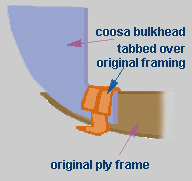 We
also made the new bulkheads with a little more of an elbow at the lowest end
to tie them into the existing plywood frame a little more aggressively. Still
trying to figure out whether it would be advantageous to put a bolt through
the coosa and the existing frame down there at the low end...on one hand it
would obviously make the attachment stronger, but on the other it would introduce
a new point in the scheme of things for water penetration and rot. Any advice
is welcome!
We
also made the new bulkheads with a little more of an elbow at the lowest end
to tie them into the existing plywood frame a little more aggressively. Still
trying to figure out whether it would be advantageous to put a bolt through
the coosa and the existing frame down there at the low end...on one hand it
would obviously make the attachment stronger, but on the other it would introduce
a new point in the scheme of things for water penetration and rot. Any advice
is welcome!
(write: webwolf@nbayracing.com)
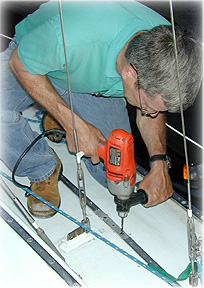 The
Rankin' RogaMan drills through a track where the new epoxy work below has closed
a pre-existing attachment point. Huge thanks to Roger and Tim2, below, for help
on the project.
The
Rankin' RogaMan drills through a track where the new epoxy work below has closed
a pre-existing attachment point. Huge thanks to Roger and Tim2, below, for help
on the project.
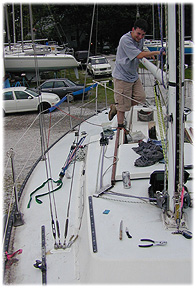
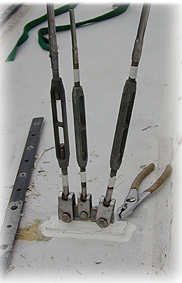 Major
league goop up with Life Caulk to prevent water penetration...should have paid
more attention to this two years ago.
Major
league goop up with Life Caulk to prevent water penetration...should have paid
more attention to this two years ago.
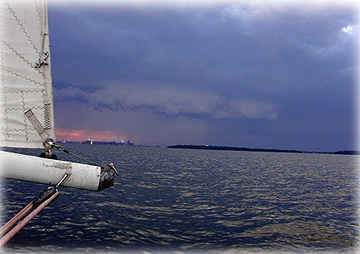 First
sail with the new boards in...wall cloud forms a mile or so off the starboard
bow. Looks like some decent puffs will test the job.......
First
sail with the new boards in...wall cloud forms a mile or so off the starboard
bow. Looks like some decent puffs will test the job.......
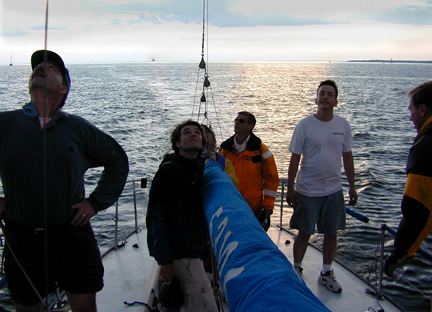 No
major puffs, we got the chute down and the motor on before gusts to 25 got to
us, but so far so good with the new bulkheads!
No
major puffs, we got the chute down and the motor on before gusts to 25 got to
us, but so far so good with the new bulkheads!